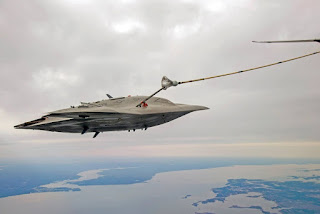Naval Drones - What to Expect in 2016
Looking Back at 2015
Our highly unscientific Twitter poll below shows what some readers thought were the most significant events in unmanned naval systems for 2015.
And Forward to 2016
What follows are our expectations, hunches, and just wild guesses of the major developments to watch for in naval unmanned systems industry during the coming year.
Sanity Prevails - After spending nearly a billion dollars and more than two decades developing the troubled Remote Minehunting System, the U.S. Navy will cancel the program. Lockheed's RMS, which was intended to be one of the Littoral Combat Ship's key mission packages, will be replaced by one or more of the growing number of versatile, less expensive mine-countermeasure UUVs.
Also, the Navy will finally make a decision to move forward with two different types of UCLASS aircraft - one optimized for deep penetrating strike, and the other for intelligence, surveillance, and reconnaissance.
Autonomy Tests - The Office of Naval Research’s Large Displacement Unmanned Underwater Vehicle Innovative Naval Prototype (LDUUV INP) will demonstrate navigation algorithms and sense-and-avoid technologies as it cruises from San Francisco to San Diego. Additionally, DARPA's Sea Hunter unmanned anti-submarine warfare surface vessel prototype will put to sea for the first time.
More Swarming Demonstrations - The development of low-cost, swarming air, surface, and sub-surface vehicles for naval warfare will continue to advance. The LOCUST UAV system should be demonstrated at sea next year.
Armed Naval Drones - Land-based UAVs, such as the MQ-1 Predator, have routinely fired weapons in combat since at least 2001. However, no armed UAVs have put to sea since the QH-50 DASH of the 1950s and 1960s carried torpedoes. This will change in next year, when the MQ-8C Fire Scout starts testing the Advanced Precision Kill Weapon System.
Industry consolidation - Large defense integrators will improve their unmanned systems portfolios by acquiring smaller upstart drone manufacturers. We saw this earlier in 2015, when Huntington Ingalls purchased Columbia Group's UUV division.
More Hybrid Vehicles - Unmanned systems that operate in more than one domain (air, surface, or sub-surface) will continue to be an interest in 2016 to naval and industry researchers. Examples such as the Naviator, Aqua-Quad, and Flimmer have begun to demonstrate the advantages of vehicles that can both swim and fly. However, it will likely be years before these types of vehicles are developed into practical operational systems.
Our highly unscientific Twitter poll below shows what some readers thought were the most significant events in unmanned naval systems for 2015.
Most significant naval drone story of 2015?
— Naval Drones (@NavalDrones) December 28, 2015
For details on these stories, see: X-47B Refueling, Russian Kanyon Nuclear UUV, UCLASS RFP |
| X-47B takes on fuel |
What follows are our expectations, hunches, and just wild guesses of the major developments to watch for in naval unmanned systems industry during the coming year.
Sanity Prevails - After spending nearly a billion dollars and more than two decades developing the troubled Remote Minehunting System, the U.S. Navy will cancel the program. Lockheed's RMS, which was intended to be one of the Littoral Combat Ship's key mission packages, will be replaced by one or more of the growing number of versatile, less expensive mine-countermeasure UUVs.
Also, the Navy will finally make a decision to move forward with two different types of UCLASS aircraft - one optimized for deep penetrating strike, and the other for intelligence, surveillance, and reconnaissance.
Autonomy Tests - The Office of Naval Research’s Large Displacement Unmanned Underwater Vehicle Innovative Naval Prototype (LDUUV INP) will demonstrate navigation algorithms and sense-and-avoid technologies as it cruises from San Francisco to San Diego. Additionally, DARPA's Sea Hunter unmanned anti-submarine warfare surface vessel prototype will put to sea for the first time.
 |
| Sea Hunter ACTUV concept - DARPA Image |
Armed Naval Drones - Land-based UAVs, such as the MQ-1 Predator, have routinely fired weapons in combat since at least 2001. However, no armed UAVs have put to sea since the QH-50 DASH of the 1950s and 1960s carried torpedoes. This will change in next year, when the MQ-8C Fire Scout starts testing the Advanced Precision Kill Weapon System.
Industry consolidation - Large defense integrators will improve their unmanned systems portfolios by acquiring smaller upstart drone manufacturers. We saw this earlier in 2015, when Huntington Ingalls purchased Columbia Group's UUV division.
More Hybrid Vehicles - Unmanned systems that operate in more than one domain (air, surface, or sub-surface) will continue to be an interest in 2016 to naval and industry researchers. Examples such as the Naviator, Aqua-Quad, and Flimmer have begun to demonstrate the advantages of vehicles that can both swim and fly. However, it will likely be years before these types of vehicles are developed into practical operational systems.

Comments
Post a Comment